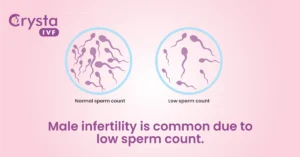Are you trying for a baby but facing roadblocks? It’s natural to wonder if everything is functioning as it should. The journey to becoming parents can be exciting but also filled with questions and uncertainties. One of the most common concerns for couples is male fertility, and a simple sperm count test, also known as a semen analysis, can be the first step toward understanding your reproductive potential.
Read More: Minimum Parameters for Healthy Sperm
The Sperm Count Test analyzes the quality and quantity of your sperm, giving you valuable insights into their number, shape, and movement. This information is crucial for your doctor to assess potential factors affecting your ability to conceive and guide you on the best path forward.
Semen analysis or Sperm Count Test enables the doctor to analyze the health and vitality of a male sperm condition. Semen is the fluid containing millions of sperms (constituting sugar and other protein elements) that are released during ejaculation. Having a healthy sperm count is vital for a successful pregnancy. Three major factors are tested during a sperm count test –
- Number of sperm
- Shape of the sperm
- Movement of the sperm (Sperm Motility)
Doctors conduct 2 – 3 separate semen analysis tests to derive the result on sperm health. The experts say the tests are done over two to three months, at least seven days apart. Wondering why they do that? Sperm count varies daily. Thus, taking multiple tests gives an average result based on which doctors derive the most conclusive results.
Who Undergo Sperm Quality Test?
Male infertility is one of the major concerns not only in India but across the world. This makes it crucial for men to get their sperm quality test done. It gives you clarity and understanding of the underlying problem. The reasons for getting Sperm Count Test done are:
- To Check for Male Infertility: Doctors recommend a Sperm Quality Test for couples having problems conceiving. The test helps in knowing if the reason behind the inability to become pregnant lies with the male partner. It also lets the doctor know whether there is a low sperm count or sperm dysfunction that is causing male infertility.
- Prior Successful Vasectomy: Men who have undergone successful vasectomy undergo semen analysis to check if no sperm is present in their semen. This tells whether the vasectomy was successful or not. It is highly recommended that men who’ve undergone vasectomy take a sperm analysis test once a month for three months, ensuring there is zero presence of sperm in their semen.
Read More: 9 Ways to Boost Male Fertility and Increase Sperm Count
Preparation For a Sperm Count Test
To prepare for a sperm count test, follow these instructions carefully for accurate results:
- No ejaculation for 24 to 72 hours before test.
- Avoid alcohol, caffeine, and any kind of drugs two to five days before the test.
- Do not consume any hormonal medication as instructed by your doctor.
- Before undergoing a sperm count test, discuss with your doctor any medication you might be using.
How to Check Sperm Count?
The sperm count test is part of the semen analysis test. The amount of sperm in semen is determined by examining the semen under the microscope to see the number of sperm in it.
There are a couple of ways through which sperm tests can be conducted. Generally, people provide a sample by masturbating and ejaculating in a special container given to them by medical experts. However, some people prefer alternative methods of semen collection due to various religious or cultural beliefs. For them, semen collection is done using a special condom during intercourse.
One common cause of low sperm count is incomplete or improper collection of semen samples. Due to frequent changes in sperm count, doctors check twice to three times to ensure consistency between samples.

To ensure accuracy, doctors ask for:
- Ensure all your semen makes it into the collection cup or collection condom when you ejaculate.
- Abstaining from ejaculating for two-three days before collecting samples.
- Collecting a second sample at least 2 weeks before the first.
- Avoiding lubricants as these products can affect sperm motility.
Semen Analysis Procedure
The semen analysis test is very easy. The process is as follows:
- Your doctor will provide you with a container cup or a container condom for collecting your semen sample.
- Once you ejaculate in the container, it will be sent to a laboratory for analysis.
- The analysis covers multiple grounds:
- Sperm Count (Number of sperm per milliliter of semen)
- Sperm Motility (Sperm Movement)
- Sperm Morphology (Shape of the sperm)
- Factors like Volume, pH, and presence of white blood cells.
Understanding the Results
- Sperm Shape: More than 50% of sperm have a typical shape, which is the expected outcome. A man’s fertility is decreased if more than half of his sperm have abnormal shapes. A lab test detects anomalies in the head, tail, or midsection of the sperm. Any abnormality in the sperm’s shape can prohibit it from successfully fertilizing with an egg.
- Sperm Motility: If your sperm can move normally even after an hour after ejaculation, it has high motility. The test determines if more than 50% of sperm is moving normally after ejaculation or not. Motility is crucial for sperm health as sperm can easily travel to the egg for fertilization. The test analyzes the sperm movement and rates it on a scale of 0 to 4. Scoring O means no movement in the sperm, and a score of 3 – 4 means good movement.
- pH Balance: A normal result requires a pH between 7.2 and 7.8. An infection may occur if the donor’s pH exceeds 8.0. If the result is less than 7.0, it can mean that the man’s ejaculatory ducts are blocked or that the specimen is contaminated.
- Volume: A typical healthy semen volume should be more than two milliliters. Low semen levels are a sign that not enough sperm are present to fertilize an egg. Another possibility for an excess fluid volume could be diluted sperm.
- Liquefaction: It should take your semen not more than 15 to 30 minutes to liquefy. Semen is initially thick, but its capacity to liquefy helps it move in the uterus. If the semen does not liquefy within 15 – 30 minutes, it can impact fertility.
- Sperm Count: 20 million to 200 million is the normal healthy sperm count in men. It means that the sperm is that much dense. If the number is low, then conceiving can be more difficult.
- Appearance: A healthy sperm color should be whitish and grey. If your semen has a tint of red-brown, it means there’s blood in it. Also, if it has a yellow tint, it could indicate jaundice or a medication side effect.
Read More: What is Azoospermia? Zero Sperm Count
Meaning of Abnormal Sperm Count:
Abnormal sperm count test results could mean that there might be infertility, infection, hormonal imbalance, or diseases such as diabetes or genetic defects. Or it could be that you were exposed to some kind of radiation.
Based on your abnormal results, your doctor can suggest you undergo the following tests:
- Genetic tests
- Hormone testing
- Urinalysis after ejaculation
- Take a tissue sample from your testicles
- Anti-sperm immune cell testing

A Sperm Count Test, or semen analysis, is a crucial diagnostic tool to assess male fertility. It evaluates sperm quantity, motility, morphology, and other factors, providing valuable insights into potential issues related to conception. Proper preparation can help with deriving accurate results. Understanding these results aids in addressing fertility challenges and considering appropriate interventions.
FAQs
Q. What is the semen analysis test price?
A. Generally, the price of a sperm count test or semen analysis test ranges from Rs. 200 – Rs. 2000, but at Crysta IVF, you can get a free semen analysis.
Q. When is it done?
A. sperm count test, also called a semen analysis, is done in the following situations:
- When trying to conceive: If you and your partner have been trying to conceive for a year (or six months if the female partner is over 35) without success, a semen analysis is one of the first tests done to examine male fertility.
- After a vasectomy: A semen analysis is performed 8-16 weeks after a vasectomy to confirm its success and ensure there are no sperm present in the semen.
- To investigate potential fertility issues: If you have any concerns about your fertility, such as low libido, erectile dysfunction, or a history of testicular injuries.
Related Blog:
Male Fertility Issues & Fertility Test for Men: What You Need to Know?
Teratozoospermia: Causes, Treatment, and Hope for Male Infertility
Comparing Azoospermia and Oligospermia: Understanding the Differences




